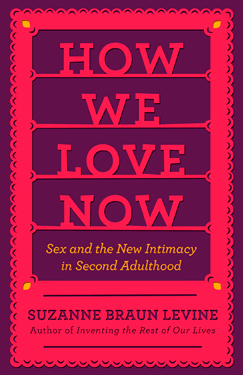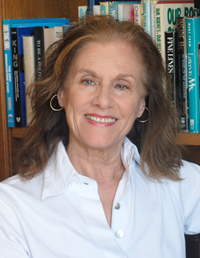|
|
|
See another section in Articles & Speeches |
|
|
ONGOING SERIES: NAVIGATING SECOND ADULTHOOD
We Are Each Other's Role Models
by Suzanne Braun Levine
From the book How We Love Now: Sex and the New Intimacy in Second Adulthood by Suzanne Braun Levine. Copyright © 2011.

We have gone through so many transformations as we shed the roles we were raised to play, that looking into the uncharted future, we expect that there is still more to discover. About becoming who we want to be. We long for someone to show the way. We look for a connection with our mothers’ experience, but we are unlikely to find the guidance we need there; instead, like her, we look to the women alongside us in a common search for authenticity.
Although there are few role models for us, in the sense of mentors and mothers sharing their wisdom about coping with experiences they have been through, we are establishing a team of guides and protectors. They are us. It has not escaped me that when I call us “we,” I am referring to women who are far enough apart in age— roughly forty- five to seventy five— to be mothers and daughters, technically different generations. But when it comes to finding support, wisdom, and intimacy that will sustain us moving forward, we are a single generation. Together we struggled to stay afloat in the midst of earth- shattering changes for women in our first adulthood, and we are struggling to assimilate those changes in our Second. I call the women who are meeting the same challenges Horizontal Role Models. They are part of this discussion about intimacy and motherhood, because they come from the same place we did— not necessarily the same town or the same college or the same family, but the same starting point. They are inventing this unprecedented stage of life alongside us.
Still, it is surprising that women coming from a span of decades can bond as equals. I was struck by this miraculous affinity in the course of moderating a discussion among twenty women; we talked intimately about everything from anger to sex to spirituality. After two hours I realized we had not yet brought up the last taboo. So I asked the women to go around the room and each tell her age. For the first time all afternoon the room fell silent. Eventually, though, everyone confessed; the range was from forty- eight to seventy-four, yet we had no problem laughing, understanding, sharing openly, totally on the same page. Our common bond is that whether we were adolescents or mothers at the time, we’re all daughters of the 1970s and 1980s.
The events of our young adulthood shaped us as much as World War II shaped “the greatest generation.” It wasn’t a matter of individual political persuasion or activism or involvement in any of the many societal changes that took place. To be alive then was to be affected. To take just one example, one that is particularly close to my tomboy heart: Whether we are now forty- eight or seventy- four, we were around when, in l972, a lawsuit (filed by a mother and daughter) opened Little League to girls and when, in 1973, Title IX opened college sports to women in parity to men. Some of the twenty women at that meeting were only in grade school back then. They got to high school in time to join the explosion of enthusiasm for girls’ sports. For others of us it was too late to take the field, but we experienced empowerment through sisters, cousins, and, yes, daughters. As girls put on uniforms and formed soccer leagues, and college women took up track, they and we on the sidelines all learned about much more than sports. We learned about teamwork and trusting other women; we learned the pleasures of open competition instead of manipulative subterfuge. We learned about sweating and physical strength. We learned it was okay to go for it ourselves, rather than just cheer others on.
As our “generation” broke through job barriers, financial double standards, unfair laws, and restrictive social practices, we defined women in new terms. As we may not be able to do with our mothers, with Horizontal Role Models we can refer back to shared experiences and forward to shared discoveries. The more we explore our potential to grow, the more those witnesses to our beginnings have to contribute. And the more attention we pay to untangling the web of our primal love relationships and establishing the openness, generosity, and mutual respect of the New Intimacy, the better we can reweave the individual strands into a safety net going forward.
Reprinted by arrangement with Viking, a member of Penguin Group (USA) Inc., from How We Love Now by Suzanne Braun Levine. Copyright © 2011 by Suzanne Braun Levine.
< back to main page

Suzanne Braun Levine is a writer, editor, blogger, activist and authority on women, family issues and media. She was the first editor of Ms. magazine (1972-1988) and the first woman editor of the Columbia Journalism Review (1989-1997). While at Ms., she produced the Peabody Award-winning documentary, “She’s Nobody’s Baby: American Women in the Twentieth Century.” She is a blogger for Huff/Post50, Vibrant Nation, The Third Age and other popular women’s sites. She is an advisor to women’s groups and media organizations, including, The Transition Network and the Women’s Media Center. She is on the Board of Civic Ventures, a nonprofit think tank on boomers, work and social purpose.
Levine’s new book – How We Love Now: Sex and the New Intimacy in Second Adulthood (Viking/2012) is the “third chapter” in her on-going conversation with women in Second Adulthood, the stage she defined and celebrated in two popular books: Inventing The Rest of Our Lives (Viking/2005) and Fifty Is the New Fifty (Viking/2009).
www.suzannebraunlevine.com
|